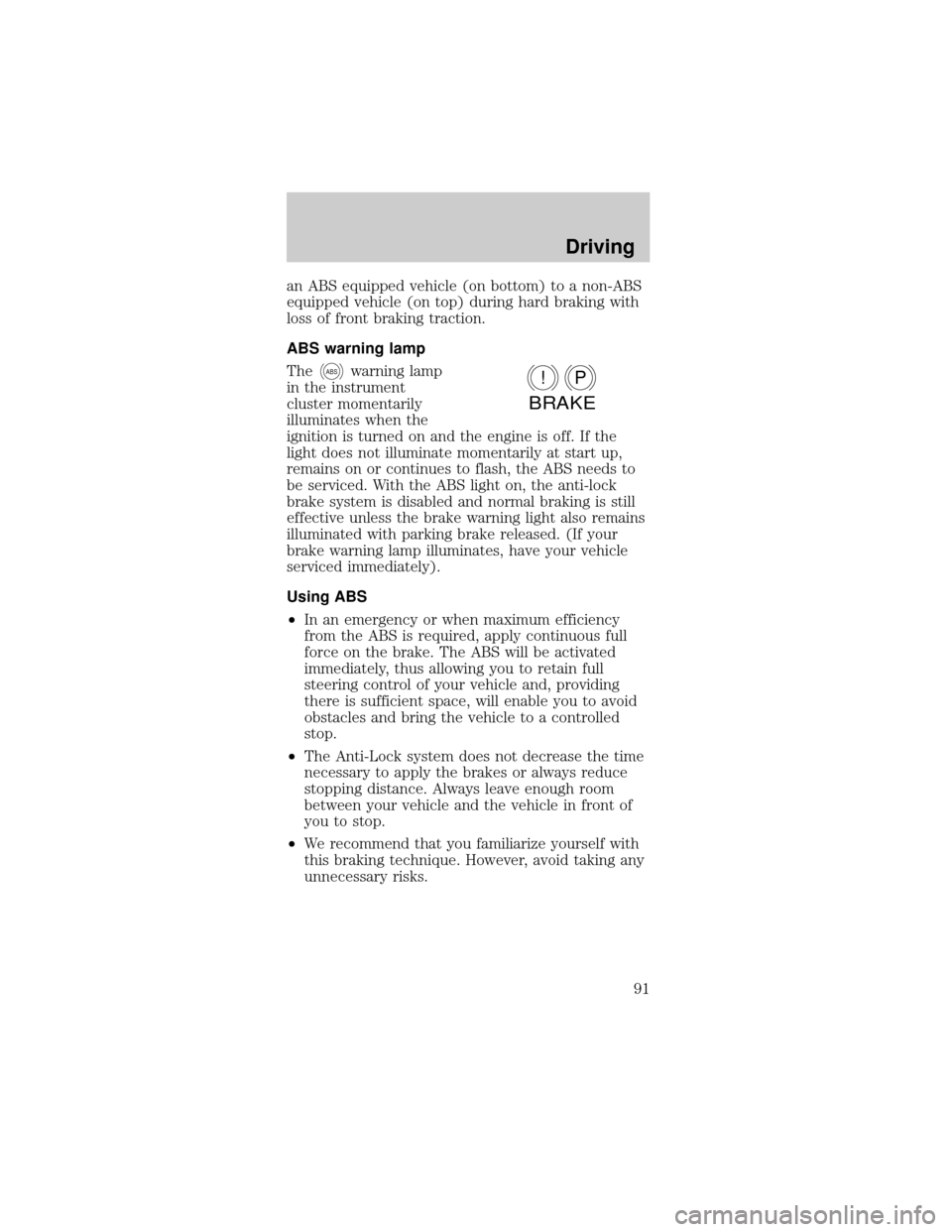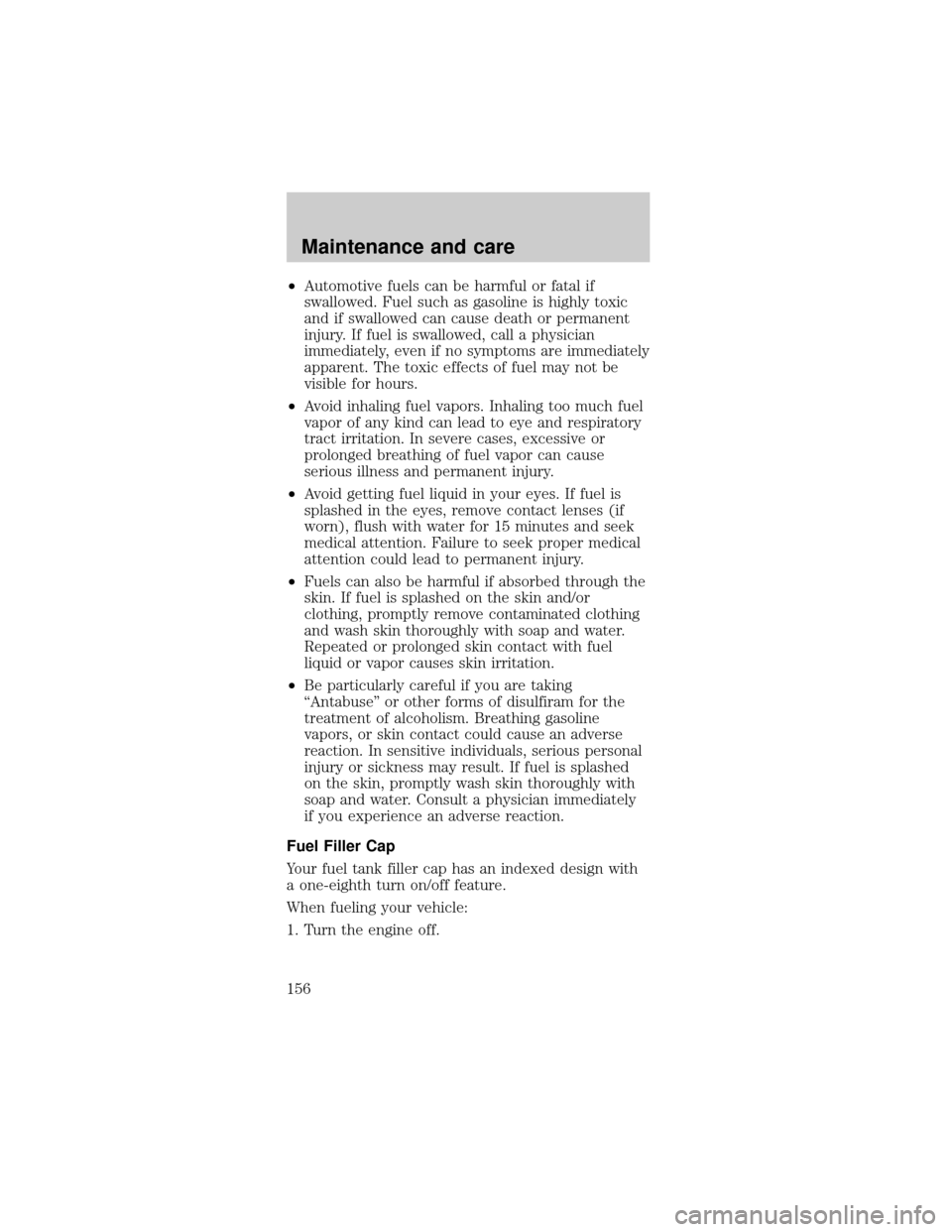1998 FORD TAURUS ABS
[x] Cancel search: ABSPage 91 of 192

an ABS equipped vehicle (on bottom) to a non-ABS
equipped vehicle (on top) during hard braking with
loss of front braking traction.
ABS warning lamp
The
ABSwarning lamp
in the instrument
cluster momentarily
illuminates when the
ignition is turned on and the engine is off. If the
light does not illuminate momentarily at start up,
remains on or continues to flash, the ABS needs to
be serviced. With the ABS light on, the anti-lock
brake system is disabled and normal braking is still
effective unless the brake warning light also remains
illuminated with parking brake released. (If your
brake warning lamp illuminates, have your vehicle
serviced immediately).
Using ABS
²In an emergency or when maximum efficiency
from the ABS is required, apply continuous full
force on the brake. The ABS will be activated
immediately, thus allowing you to retain full
steering control of your vehicle and, providing
there is sufficient space, will enable you to avoid
obstacles and bring the vehicle to a controlled
stop.
²The Anti-Lock system does not decrease the time
necessary to apply the brakes or always reduce
stopping distance. Always leave enough room
between your vehicle and the vehicle in front of
you to stop.
²We recommend that you familiarize yourself with
this braking technique. However, avoid taking any
unnecessary risks.P!
BRAKE
Driving
91
Page 94 of 192

SEMI-ACTIVE RIDE CONTROL
(TAURUS SHO ONLY)
Firm shock absorber performance enhances ride and
handling during certain road conditions. The shock
absorber is returned to a softer performance when
driver or road induced motion ceases. This system is
automatic and requires no driver input.
AUTOMATIC TRANSAXLE OPERATION
Brake-shift interlock
This vehicle is equipped with a brake-shift interlock
feature that prevents the gearshift from being moved
from P (Park) unless the brake pedal is pressed.
If you cannot move the gearshift out of P (Park)
with the brake pedal depressed:
1. Apply the parking brake, turn ignition key to
LOCK, then remove the key.
2. Insert the key and turn it to OFF. Apply the brake
pedal and shift to N (Neutral).
3. Start the vehicle.
If it is necessary to use the above procedure to
move the gearshift, it is possible that a fuse has
blown and the vehicle's brakelamps may not be
operating properly. Refer toFuses and relaysin the
Roadside emergencieschapter.
Do not drive your vehicle until you verify
that the brakelamps are working.
If your vehicle gets stuck in mud or snow it may be
rocked out by shifting from forward and reverse
gears, stopping between shifts, in a steady pattern.
Press lightly on the accelerator in each gear. Do not
rock the vehicle for more than a few minutes,
because it could damage the vehicle.
Driving
94
Page 112 of 192

The fuses are coded as follows.
Fuse/
Relay
LocationFuse
Amp
RatingDescription
1 Ð Not Used
2 5A Instrument Illumination
3 10A Left Low Beam Headlamp
4 10A Right Low Beam Headlamp
5 5A Brake Shift Interlock, Rear
Defrost
6 15A MLPS Switch, Backup Lamps,
Speed Control
7 10A MLPS Switch, Starter Relay
8 5A Power Antenna, RCU, GEM
9 10A ABS
10 20A PCM Relay, Ignition Coil, PATS,
Radio
11 5A Instrument Cluster
12 5A Instrument Cluster, Autolamps,
Transmission Control Switch,
ICP, GEM
13 5A Air Bag, Blower Motor, EATC
14 5A Air Suspension
15 10A Multi-Function Switch (Turn
Signal)
16 Ð Not Used
17 30A Front Wiper/Washer
18 5A Headlamp Switch
19 15A Rear Wiper/Washer
20 5A ICP, RAP, Phone
21 20A Cigar Lighter
22 5A Power Mirrors, Power Antenna,
Decklid Lamps, Autolamp
23 5A GEM, RAP, PATS
Roadside emergencies
112
Page 156 of 192

²Automotive fuels can be harmful or fatal if
swallowed. Fuel such as gasoline is highly toxic
and if swallowed can cause death or permanent
injury. If fuel is swallowed, call a physician
immediately, even if no symptoms are immediately
apparent. The toxic effects of fuel may not be
visible for hours.
²Avoid inhaling fuel vapors. Inhaling too much fuel
vapor of any kind can lead to eye and respiratory
tract irritation. In severe cases, excessive or
prolonged breathing of fuel vapor can cause
serious illness and permanent injury.
²Avoid getting fuel liquid in your eyes. If fuel is
splashed in the eyes, remove contact lenses (if
worn), flush with water for 15 minutes and seek
medical attention. Failure to seek proper medical
attention could lead to permanent injury.
²Fuels can also be harmful if absorbed through the
skin. If fuel is splashed on the skin and/or
clothing, promptly remove contaminated clothing
and wash skin thoroughly with soap and water.
Repeated or prolonged skin contact with fuel
liquid or vapor causes skin irritation.
²Be particularly careful if you are taking
ªAntabuseº or other forms of disulfiram for the
treatment of alcoholism. Breathing gasoline
vapors, or skin contact could cause an adverse
reaction. In sensitive individuals, serious personal
injury or sickness may result. If fuel is splashed
on the skin, promptly wash skin thoroughly with
soap and water. Consult a physician immediately
if you experience an adverse reaction.
Fuel Filler Cap
Your fuel tank filler cap has an indexed design with
a one-eighth turn on/off feature.
When fueling your vehicle:
1. Turn the engine off.
Maintenance and care
156
Page 157 of 192

2. Carefully turn the filler cap counterclockwise 1/8
of a turn until it stops.
3. Pull to remove the cap from the fuel filler pipe.
4. To install the cap, align the tabs on the cap with
the notches on the filler pipe.
5. Turn the filler cap clockwise 1/8 of a turn until it
stops.
If the ªService Engine Soon/Check Engine ª indicator
comes on and stays on when you start the engine,
the fuel filler cap may not be properly installed.
Turn off the engine, remove the fuel filler cap and
reinstall it being careful to align the cap properly.
If you must replace the fuel filler cap, replace
it with an authorized Motorcraft part. The
customer warranty may be void for any damage
to the fuel tank or fuel system if an authorized
Motorcraft fuel filler cap is not used.
The fuel system may be under pressure. If
the fuel filler cap is venting vapor or if you
hear a hissing sound, wait until it stops before
completely removing the fuel filler cap. Otherwise,
fuel may spray out and injure you or others.
If you do not use the proper fuel filler cap,
the pressure in the fuel tank can damage
the fuel system or cause it to work improperly in a
collision.
Maintenance and care
157
Page 164 of 192

3. Release clip and
disconnect the
electrical connector
from the bulb.
4. Remove the bulb
retaining ring by
rotating it
counterclockwise
(when viewed from the
rear) about 1/8 turn to
free it from the bulb socket, and slide the ring off
the plastic base. Keep the ring to retain the new
bulb.
5. With out turning, remove the old bulb from the
lamp assembly by gently pulling it straight out of the
lamp assembly.
To install the new bulb:
1. With the flat side of
the bulb's plastic base
facing upward, insert
the glass end of the
bulb into the lamp
assembly. You may
need to turn the bulb left or right to align the
grooves in the plastic base with the tabs in the lamp
assembly. When the grooves are aligned, push the
bulb into the lamp assembly until the plastic base
contacts the rear of the lamp assembly.
2. Install the bulb retaining ring over the plastic base
until it contacts the rear of the socket by rotating
clockwise until you feel a ªstop.º
3. Install the electrical connector into the rear of the
plastic base until it snaps, locking it into position.
4. Turn the headlamps on and make sure they work
properly. If the headlamp was correctly aligned
before you changed the bulb, you should not need to
align it again.
Maintenance and care
164
Page 186 of 192

Air bag supplemental
restraint system ........ 67
and child safety
seats ......................... 69
description .............. 67
disposal .................... 72
indicator light ......... 72
passenger air bag ... 70
Air conditioning
automatic temperature
control
system . 22,23,24,25,27
Anti-theft system ...... 47
arming the system .. 47
Automatic transaxle . 94
driving
with ......... 97,98,99,100
Brakes ........................ 90
anti-lock ................... 90
anti-lock brake
system (ABS)
warning light ........... 91
fluid, checking and
adding .................... 136
shift interlock .......... 94
Break-in period ........... 3
Cargo cover .......... 42,43
Cargo net .............. 41,42
Cellular telephone
(see your Cellular
Phone Guide) ............ 40
Child safety seats
attaching with tether
straps ....................... 79
in rear seat ......... 76,78
tether anchorage
hardware ................. 79
Cleaning your
vehicle ...................... 169
built-in
child seat ....... 80,81,84engine
compartment .. 170,172
exterior lamps ....... 173
plastic parts .......... 172
washing .................. 169
waxing ................... 170
wheels .................... 170
wiper blades .......... 173
Console ...................... 39
Controls
power seat ............... 56
Coolant .................... 140
checking
and adding ............ 138
refill capacities ...... 140
Defrost
rear window ............ 18
Doors
central
unlocking ............ 37,38
Emission control
system ...................... 160
Engine
coolant ................... 137
idle speed control . 144
service
points ....... 130,131,132
starting after a
collision ................. 109
Engine block heater . 88
Engine oil
checking and
adding .................... 134
dipstick .................. 133
specifications . 133,135
Exhaust fumes .......... 88
Floor mats ................. 40
Fuel
choosing the
right fuel ................ 158
detergent in fuel ... 160
Index
186
Page 187 of 192

filling your vehicle
with fuel ......... 155,156
quality .................... 159
running out of fuel 160
safety information
relating to
automotive fuels ... 155
Fuses ................. 110,111
Hazard flashers ....... 109
Head restraints ......... 55
Headlamps
high beam ............... 16
Heating ...................... 18
heating and air
conditioning
system ........... 18,19,20
Hood ........................ 129
Ignition ..................... 180
Inspection/maintenance
(I/M) testing ............ 162
Instrument panel
cleaning ................. 173
Keyless entry system
autolock ................... 52
keypad ..................... 50
locking and
unlocking doors ...... 51
programming entry
code .................... 50,51
Keys
key in ignition
chime ....................... 12
positions of the
ignition .................... 28
Lamps ...................... 163
autolamp system ..... 17
daytime running
light .......................... 16
headlamps ............... 16
headlamps, flash to
pass .......................... 17instrument panel,
dimming ................... 17
interior lamps ....... 166
replacing
bulbs ............... 163,166
Lane change indicator
(see Turn signal) ...... 33
Liftgate ...................... 44
remote release ........ 41
Lights, warning and
indicator
air bag ...................... 11
anti-lock brakes
(ABS) ...................... 10
anti-theft ................... 9
brake ........................ 10
charging system ...... 11
cruise indicator ....... 10
door ajar .................... 7
low coolant ................ 9
low fuel ...................... 9
oil pressure ............. 10
overdrive off .............. 9
safety belt ................. 7
service engine
soon ........................ 7,8
speed control .......... 32
turn signal indicator . 6
Locks .......................... 53
childproof ................ 39
Luggage rack ........... 108
Lumbar support,
seats ...................... 56,57
Mirrors
heated ...................... 38
side view mirrors
(power) ................... 38
Moon roof .................. 35
Motorcraft parts ...... 160
Octane rating ... 158,159
Odometer ................... 14
Overdrive .............. 95,96
Index
187